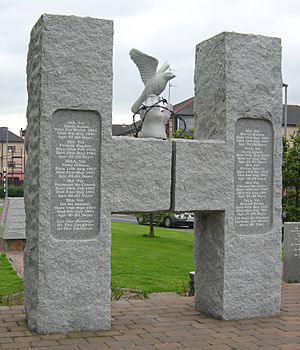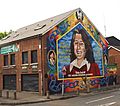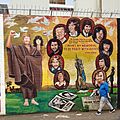1981 Irish hunger strike facts for kids

The 1981 Irish Hunger Strike was a serious hunger protest by prisoners in Northern Ireland. These prisoners were Irish Republicans, meaning they wanted Northern Ireland to be part of the Republic of Ireland. The protest happened during a time of conflict known as the Troubles. During this protest, ten prisoners died. One of them, Bobby Sands, was even elected as a Member of Parliament (a type of politician) in the United Kingdom before he passed away.
Contents
What Was the Hunger Strike About?
The prisoners were protesting against changes to their status. Before 1976, they were treated as "special category" prisoners. This meant they were seen more like political prisoners than regular criminals. They had certain rights, like wearing their own clothes and not doing prison work.
Loss of Special Status
In 1976, the British government ended this special status. They wanted to treat all prisoners the same. This meant Irish Republican prisoners had to wear prison uniforms and do prison work. They felt this was unfair and that they were being treated like ordinary criminals.
The Blanket and Dirty Protests
To fight back, prisoners started the "blanket protest." They refused to wear prison uniforms. Instead, they wrapped themselves in blankets. When this didn't work, they began the "dirty protest." They refused to wash or empty their chamber pots. They smeared their cells with their own waste. This was a very harsh way to protest.
The 1980 Hunger Strike
In 1980, a group of seven prisoners started a hunger strike. They refused to eat any food. They hoped this would make the British government give them back their special status. After 53 days, the strike ended without their demands being met. One prisoner, Sean McKenna, became very ill and almost died.
The 1981 Hunger Strike Begins
The prisoners felt they had no other choice. On March 1, 1981, Bobby Sands started a new hunger strike. He was the first of ten prisoners who would die during this protest. The prisoners started their fasts one by one, a few days apart. This was meant to put more pressure on the government.
Bobby Sands Becomes an MP
While Bobby Sands was on hunger strike, a special election was held. He was chosen by voters to become a Member of Parliament for Fermanagh and South Tyrone. This showed how much support he had. However, the British government still refused to give in to the prisoners' demands.
The Deaths of the Strikers
Bobby Sands died on May 5, 1981, after 66 days without food. His death caused a lot of sadness and anger. Nine more prisoners died over the next few months. Their names were Francis Hughes, Raymond McCreesh, Patsy O'Hara, Joe McDonnell, Martin Hurson, Kevin Lynch, Kieran Doherty, Thomas McElwee, and Michael Devine.
How the Strike Ended
The hunger strike finally ended on October 3, 1981. The families of the remaining hunger strikers decided to allow medical help for their loved ones. They did not want any more deaths. The strike did not fully achieve its goals. However, some changes were made later. Prisoners were allowed to wear their own clothes. They also did not have to do prison work.
Impact of the Hunger Strike
The 1981 hunger strike had a huge impact on Northern Ireland. It brought a lot of attention to the conflict. It also increased support for Irish Republican groups. Many people around the world watched the events unfold. It remains a very important and sad part of the history of the Troubles.
Images for kids
-
Terence MacSwiney, an Irish republican who died on hunger strike in Brixton Prison in 1920
-
A mural of Bobby Sands in Belfast
-
A hunger strike memorial near Crossmaglen, County Armagh
See also
 In Spanish: Huelga de hambre de 1981 en Irlanda del Norte para niños
In Spanish: Huelga de hambre de 1981 en Irlanda del Norte para niños








